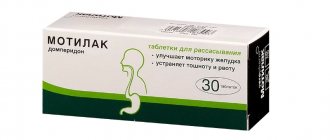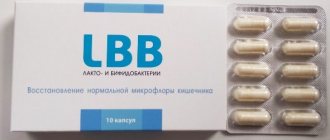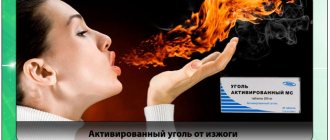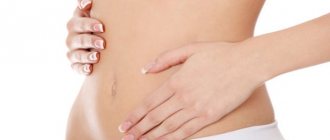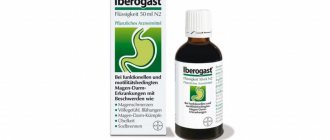Quite often there are cases when a person begins to be bothered by such unpleasant symptoms as nausea, causeless vomiting, and abdominal pain. Such signs without proper treatment and immediate response can lead to diseases that will require complex treatment in the future. Therefore, in order to relieve abdominal pain, eliminate nausea and vomiting, the doctor prescribes the modern and effective medicine Motilium, the indications for use of which are described in detail in the instructions. The drug is able to block peripheral and central receptors of the brain, effectively eliminating the symptoms of diseases associated with the gastrointestinal tract, nausea and vomiting.
Pharmacological properties of the drug Motilium
Pharmacodynamics . Domperidone is a dopamine antagonist that has antiemetic effects similar to metoclopramide and some antipsychotics. However, unlike these drugs, it practically does not penetrate the BBB. The use of domperidone is rarely accompanied by extrapyramidal side effects, especially in adults, but it stimulates the release of prolactin from the pituitary gland. Its antiemetic effect is due to a combination of peripheral (gastrokinetic) action and antagonism to dopamine receptors in the chemoreceptor trigger zone, which is located outside the BBB, in the gastrema zone. Animal studies, as well as low concentrations in the brain, indicate a predominant peripheral effect of domperidone on dopamine receptors. Human studies have shown that domperidone increases the duration of peristaltic contractions of the antrum of the stomach and duodenum, accelerates gastric emptying - the release of liquid and semi-liquid fractions in healthy people and solid fractions in patients in whom this process has been slowed down, and also increases the tone of the lower sphincter esophagus in healthy people. Does not affect gastric secretion. Pharmacokinetics . Domperidone is rapidly absorbed when taken orally on an empty stomach, with maximum plasma concentrations achieved within 30–60 minutes. The low bioavailability of oral domperidone (about 15%) is due to extensive metabolism in the intestinal wall and liver. In healthy people, bioavailability increases after meals; patients with gastrointestinal complaints should take domperidone 15–30 minutes before meals. Reduced gastric acidity reduces the absorption of domperidone. Bioavailability decreases after taking cimetidine or sodium bicarbonate. When taken orally, domperidone does not accumulate and does not induce its own metabolism; The maximum plasma level at 90 minutes (21 ng/mL) after 2 weeks of oral dosing of 30 mg per day was the same as after the first dose (18 ng/mL). Domperidone is 91–93% protein bound. Studies of the drug's distribution in the body have shown significant accumulation in tissues, but low concentrations in the brain. The concentration of domperidone in mother's milk is lower than the corresponding concentration in plasma. By hydroxylation and N-dealkylation, domperidone is rapidly and extensively metabolized in the liver. In vitro metabolism studies with a diagnostic inhibitor showed that CYP 3A4 is the main form of cytochrome P450 that is involved in N-dealkylation, keeping in mind that CYP 3A4 and CYP 2E1 are involved in the aromatic hydroxylation of domperidone. Excretion in feces and urine accounts for 31 and 66% of the dose, respectively. The excretion of the drug in unchanged form is 10% in feces and 1% in urine. The plasma half-life after a single dose is 7–9 hours in healthy individuals, but is prolonged in patients with severe renal impairment.
Pharmacological qualities of the drug
Motilium. Lozenges
Motilium refers to medications that are aimed at stimulating intestinal motility and suppressing the urge to vomit. The main effect of the drug is provided by domperidone, which acts like some antipsychotics and metoclopramide, which are antagonists of dopapine.
This type of medication causes virtually no side effects, since it has poor permeability through the blood-brain barrier. However, sometimes children may experience unwanted side effects of the drug. Thanks to the main, active substance, prolactin is released from the pituitary cells.
The drug copes well with gastric emptying and helps increase the duration of duodenal and antral contractions.
When the medicine is taken orally in an adult, the evacuation of solid and liquid food from the stomach is much easier, while in sick patients, when the evacuation of solid food is slowed down, this process is much faster and better. Taking the medicine in a healthy person normalizes the tone and pressure in the esophageal sphincter area. However, the medicine does not have a negative effect on the secretion of gastric juice.
Indications for use of the drug Motilium
A complex of dyspeptic symptoms associated with delayed gastric emptying, gastroesophageal reflux, esophagitis (feeling of stomach fullness, heaviness in the epigastric region, feeling of bloating, pain in the upper abdomen, belching, flatulence, nausea, vomiting, heartburn with reflux of stomach contents into mouth or without casting); nausea and vomiting of functional, organic, infectious or dietary origin, as well as caused by radiation therapy or emetogenic chemotherapy; nausea and vomiting caused by dopamine agonists (levodopa, bromocriptine).
When is Motilium contraindicated?
It is prohibited to use the medicine:
- in case of danger of perforation of a gastric ulcer, development of internal bleeding;
- in case of intestinal obstruction;
- in case of dysfunction, neoplasms in the pituitary gland;
- prolactinoma;
- severe kidney or liver damage;
- individual intolerance to any of the components of the drug.
If you are allergic to Motilium, itching, hyperemia, rash, lacrimation, and swelling of the mucous membranes are likely to occur. In such cases, discontinuation of therapy and replacement of the drug with another is required.
Use of the drug Motilium
Chronic dyspepsia Adults: 10 mg (1 tablet) 3 times a day 15–30 minutes before meals and, if necessary, before bedtime. If necessary, the dose can be doubled. The maximum daily dose of doperamidonate is 2.4 mg/kg, but not 80 mg. Acute and subacute conditions Adults: 20 mg (2 tablets) 3-4 times a day before meals, if necessary, before bedtime. Children over 12 years of age : 1-2 tablets of 10 mg 3-4 times a day 15-30 minutes before meals, if necessary - before bed, but not 80 mg/day. Children aged 3 to 12 years: 0.25–0.5 mg 3–4 times a day 15–30 minutes before meals. The maximum dose is 80 mg. In case of renal failure, it is recommended to reduce the frequency of taking the drug.
Comparison of addiction between Motilium and Domperidone-teva
Like safety, addiction also involves many factors that must be considered when evaluating a drug.
So, the totality of the values of such parameters as “o syndrome” in Motilium is quite similar to the similar values in Domperidon-teva. Withdrawal syndrome is a pathological condition that occurs after the cessation of intake of addictive or dependent substances into the body. And resistance is understood as initial immunity to a drug; in this it differs from addiction, when immunity to a drug develops over a certain period of time. The presence of resistance can only be stated if an attempt has been made to increase the dose of the drug to the maximum possible. At the same time, in Motilium the meaning of the “syndrome” is quite small, however, the same as in Domperidon-teva.
Special instructions for the use of the drug Motilium
When taken in combination with antacids or antisecretory drugs, it should be taken after meals and not at the same time. Motilium should not be prescribed to patients with lactose intolerance, galactosemia and glucose malabsorption. In case of liver diseases , prescribe with caution due to the high level of metabolism of the drug in the liver. For kidney diseases in patients with severe renal failure, when Motilium is re-administered, the frequency of administration is reduced to 1-2 times a day, depending on the severity of the condition. During long-term therapy, the patient must remain under constant supervision. During pregnancy and breastfeeding. Motilium should be prescribed only when the expectation of a therapeutic effect is justified and the risk is eliminated. During breastfeeding, the use of Motilium is not recommended. In therapeutic doses, Motilium does not affect the ability to drive vehicles or operate machinery.
Side effects caused by taking Motilium. Contraindications
Motilium. Release form - tablets
It is very rare to find medications that do not cause side effects. Even drugs that have a natural base are not suitable for everyone. Therefore, Motilium is no exception. Side effects can be severe or moderate, sometimes even unnoticed. The most common side effects are:
- in the endocrine system. In this case, gynecomastia, galactorrhea, and hyperprolactinemia develop;
- in the central nervous system. In this case, extrapyramidal disorders are observed, which disappear as soon as you stop taking the suspension or tablets;
- in the digestive system. In this case, a disorder of the gastrointestinal tract is very rarely observed, and spasmodic contraction of the intestine is very rarely observed.
After examining the patient and child, the doctor will tell you whether Motilium can be taken as a remedy. Thus, in case of perforation of the stomach or intestines or its obstruction as a result of a mechanical disorder, it is better to replace the drug with another more suitable medicine. It is also contraindicated for people who suffer from prolactinoma. If they have gastrointestinal bleeding, their body cannot tolerate one of the components of this drug.
Interactions of the drug Motilium
Anticholinergic drugs may counteract the effects of Motilium. Antacid and antisecretory drugs, when taken simultaneously with Motilium, reduce its bioavailability. When used simultaneously with ketoconazole (a cytochrome P450 inhibitor), which inhibits the primary metabolism of domperidone, there is a 3-fold increase in the maximum concentration of domperidone and an increase in AUC in the plateau phase. As a result, it is not recommended to prescribe azole drugs, macrolides, HIV protease inhibitors, and nefazodone simultaneously with domperidone. Also, when used with ketoconazole, an increase in the QT by 10-20 ms may be observed. Digoxin and paracetamol, when used simultaneously with domperidone, do not affect the level of these drugs. Motilium mezhet combines with: • neuroleptics, enhances their effect. • dopamine agonists (levodopa, bromocriptine).
Comparison of side effects of Motilium and Domperidone-teva
Side effects or adverse events are any adverse medical event that occurs in a subject after administration of a drug.
Motilium has almost the same level of adverse events as Domperidone-teva. They both have few side effects. This implies that the frequency of their occurrence is low, that is, the indicator of how many cases of an undesirable effect of treatment are possible and registered is low. The undesirable effect on the body, the strength of influence and the toxic effect of Motilium are similar to Domperidone-teva: how quickly the body recovers after taking it and whether it recovers at all.
How can I replace Motilium?
The most famous analogues and generics of the drug:
- Domrid;
- Domidon;
- Domperidone Hexal;
- Motinorm;
- Motoricum;
- Motilak;
- Peridonium.
You should not change the medicine to an alternative one on your own. In addition to differences in dosage, some of them have a wider list of contraindications; not all are approved for use in pediatrics.
Research and effectiveness
Compared to other prokinetic agents, domperidone is the safest. It has a serious limitation for use - cardiovascular disease. Domperidone is not prescribed to patients with existing or past heart disease.
Motilak in the form of lozenges provides a quick onset of effect. Absorption of the drug occurs in the oral cavity. It is convenient to take on the road, outdoors, while traveling.
Motilium, in addition to tablets, is available in the form of a suspension. This form of release of the drug is convenient for children under 12 years of age.
Domperidone-based drugs have the following restrictions:
- are prescribed for the shortest possible period, no more than 7 days;
- maximum dose – 30 mg/day;
- used only for the treatment of vomiting and nausea;
- should not be used in patients with electrolyte disturbances.
Sources:
- “Safety of the use of prokinetics in the practice of a therapist using the example of domperidone (Motilac).” Arkhipov V.V. 2007.
- "Limitations of the use of Motilium due to cardiac side effects." Ministry of Health, State of Israel. 2014.
Compound
Motilium film-coated tablets Active ingredient (in 1 tablet): domperidone 10 mg. Inactive ingredients: corn starch, lactose, pre-gelatinized potato starch, microcrystalline cellulose, magnesium stearate, polyvidone, hydrogenated vegetable oil, sodium lauryl sulfate, hypromellose. Motilium suspension Active ingredient (in 5 ml): domperidone 5 mg. Inactive substances: propyl parahydroxybenzoate, microcrystalline cellulose, sodium carboxymethylcellulose, sorbitol, sodium saccharinate, methyl parahydroxybenzoate, polysorbate, sodium hydroxide, purified water. Lingual tablets Motilium Active ingredient (in 1 tablet): domperidone 10 mg. Inactive ingredients: aspartame, gelatin, mannitol, mint flavor.
Pregnancy
There is insufficient information on the use of the drug in pregnant women. There is no data on the provocation of developmental abnormalities in children whose mothers took Motilium.
However, the appointment of Motilium is recommended only when the therapeutic benefit for the mother outweighs the potential risks for the child (fetus). It is especially not recommended to prescribe the drug before 12 weeks of pregnancy.
The concentration of the active substance Motilium in women's breast milk is 10-50% of the plasma concentration, but not more than 10 ng/ml. When taking the maximum allowable dosage, the total amount of domperidone that passes into breast milk is not less than 7 mcg per day. There is currently no information whether this concentration of domperidone has a negative effect on breastfed infants. It is recommended, if taking Motilium during lactation is necessary, to refrain from breastfeeding (except for the predominance of the expected benefits over the possible risks).

